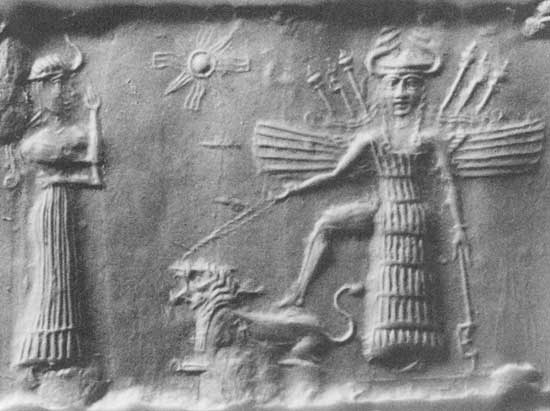
A one-off painting might come from any old idea; many of their origins would be dull to describe. But a series of paintings, as in the case of the Blue Leahs, often has an interesting genesis.
I am finding that in my case, at least, a series of partial concepts -- I'll call them partials in tribute to Greg Bear -- swirls around my mind. Eventually, they might link up with other partials, and eventually there is a whole thing -- an idea for a series of paintings.
Let me lead you on a path through some partials, and we will see what it summed up to:
Partial 1: Hypercolor
This is a painting I did late in 2010. It currently lives at Hilliard Gallery in Missouri, whither I encourage you to run and buy it:

Daniel Maidman, La Mémoire, 2010, oil on canvas, 18"x14"
"Sangre de dios, Maidman, this is not your usual style at all!" quoth you. True. Let me explain. Ordinarily, the way I paint something is I draw a fussy underdrawing, as you can see here, because I hate to try to put things in the right place at the same time that I'm dealing with color and value. Then, I choose an undercoat color which I spread over the canvas by means of some turpenoid and a cloth. Then I paint into this undercoat while it is wet.
In this instance, I did the underdrawing and the undercoat, then took a step back and said, "You know what, I like this a lot. I think I'll leave it like it is."
This idiom gnawed at me; I wanted to do more paintings in the same mode. In fact, I tried it twice, with distinctly mixed results:

Daniel Maidman, The Prayer, 2010-11, oil on canvas, 14"x18"

Daniel Maidman, Nursing, 2010, oil on canvas, 24"x18"
These are OK, I think, but what's missing from them is the accidental quality of the first one. I meant to do these as they are.
After the third one, I decided to leave it alone for a while, because clearly I had no idea what to do or how to do it. But something important about it struck me: it is the first idiom I've discovered in which I could consider doing a narrative painting, with a story and characters and everything. You can see this emerging in the third painting.
In the past, I could not support narrative, with sincerity, in my work. In this one idiom, I can easily picture it.
I've been calling the idiom hypercolor.
Partial 2: Frankenthaler
With hypercolor running in my mental background, my mind eventually drifted to color field painter Helen Frankenthaler.

Helen Frankenthaler, Canal, 1963, Acrylic on canvas, 81" x 57 1/2", Solomon R. Guggenheim Museum, New York (complete credits at bottom of article)
For me, there are two Frankenthalers -- the actual Frankenthaler paintings, and the idea of Frankenthaler. I dig the actual paintings in flashes, but for some years, I have continuously dug the idea: the large, irregular zones of color, placed with a seeming indifference to the elements of design -- and yet, for all this seeming indifference, working.
(As an aside, I think this mode of appreciation of the work shades into what the conceptual artists get at, that the work itself is detritus, vanishable, a codec of an idea: the artist compresses the idea, and the viewer decompresses it, so that the true art exists in the mind on either side, and the quality of the work as a disposable transmission medium is foregrounded.)
When I began to recognize Frankenthaler as a second partial, I did a little research into how she made her paintings. Turns out, her method of application was frequently the same as the one I stumbled on with the hypercolor partial -- non-brush application of oil paint, heavily thinned with turpentine. I know where she's coming from in terms of the physical question of moving paint to surface.
What I learn from Frankenthaler is the possibility of integrating a large canvas area into a single composition using the broad category of color shapes. Do you see why this is important? Consider Rauschenberg (sorry, you'll have to follow the link -- I couldn't get the rights to this one). In the 1954 Charlene, Rauschenberg also demonstrates that a large picture space can be compositionally unified. But he uses so many elements that the fact that he's not actually making a representational image is almost beside the point.
Charlene bears a strong formal resemblance to, for instance, neoclassical history painting.

Jacques-Louis David, The Intervention of the Sabine Women, 1799, oil on canvas, 152"x206"
Now consider Frankenthaler again:

Helen Frankenthaler, Canal, 1963, Acrylic on canvas, 81" x 57 1/2", Solomon R. Guggenheim Museum, New York (complete credits at bottom of article)
This painting is enormous, nor is it busy, but it holds together, and it holds together using an array of elements more in line with what I'm interested in.
So I added Frankenthalerian composition to hypercolor technique in the swirl of partials building toward a project in my mind.
Partial 3: Cassandra Rosebeetle
I always try to match the project to the model, and the model to the project. And as this project germinated, it occurred to me that it suited Cassandra Rosebeetle, an absolutely stellar model I first met in Los Angeles. We moved to New York around the same time, and I've drawn and painted her here. This is a painting of Cassandra:

Daniel Maidman, Merops Iphikrates, 2009, oil on canvas, 60"x36"
This is another:

Daniel Maidman, The Sister of the Storm, 2010, oil on canvas, 60"x36"
Something you would only vaguely figure out from looking at this work is that Cassandra is a dancer with a flair for costume...

...and a taste for the alchemical:

Cassandra's performances are riotously fun to attend, and painting her is one of the great pleasures of my life as an artist.
When I hit on making large paintings of Cassandra, using the hypercolor combination of refined underdrawings and washy color fields, and the Frankenthalerian integration of the picture space, I thought I had completed assembly of partials into a project, and I was excited to start...
But no ideas came to me. I doodled a couple possibilities, but "random naked chick + color" wasn't cutting it for me. Grumbling, I had to move the project from "active" back to "pending," and wait for further inspiration to strike.
Partial 4: Inanna
I'm not sure how this idea emerged. It's probably just a synthesis of a few things -- that Cassandra casts a mythogenic field around her, that I'm interested in the harrowing in hell to begin with -- but I eventually thought again about the Sumerian goddess Inanna, and from there came to the strange story of her descent into the underworld.
Inanna is a goddess of war and unlawful carnal knowledge. Also a virgin goddess. And one time she pulled a Prometheus and proliferated technology to the people of Uruk. Nobody's going to accuse the Sumerians of theological consistency.

Be that as it may, Inanna, for reasons not entirely explicit, decided to go down into the underworld and have it out with her older sister Ereshkigal, who ruled there.
It turned out hell had seven gates, at each of which a gatekeeper demanded one of Inanna's garments, which also functioned as instruments of her powers. You could call this part of the story The Deadliest Striptease. Inanna entered the underworld naked, which comports with my motto, "It is only naked you will enter into the house of the truth," as well as with Cassandra's talent for burlesque.
When Inanna met up with Ereshkigal, she died, and Ereshkigal hanged her on a hook. She hanged dead for three days before Father Enki's minions showed up, applied the life-giving plant and the life-giving water, and busted her on outta there.
Maybe she gained the power of life and death. It's not clear. Sumerians.
Now, this story motivates some nudes (you may have noticed I'm not averse to nudes). It provides a character Cassandra can play to a T, a narrative to match the hypercolor idiom, and a mythological context complimentary to the Frankenthaler landscape. But more than that, it is a story I find personally moving.
I do believe that we must all be harrowed in hell -- that we are all Dante, and we will never leave our dark forest except if we go downward. I do believe that we must die and be born again. I believe we must stake our souls, going naked into the house of the truth, if we are to be saved. I believe we must abandon every hope, even the hope of salvation, before salvation will come down to us, and we will emerge glorious from our wretchedness. I believe we must do this again and again; that we will be weary, and will believe that we have done with it -- and then the dilemma will re-emerge, and again, we will be forced either to become directionless grey ghosts, or to go down to the dark room, and the hook, and the hopelessness, before the life-giving plant and the life-giving water are bestowed.
This is a story I believe; it is a story I can tell.
So this was the final partial -- now the project is ready to begin, telling this story, this way, in twelve or fifteen paintings.
I will keep you posted on how it goes.
---
Endnotes
Frankenthaler's Canal -- reproduced with the generous permission of the Solomon R. Guggenheim Museum. Complete picture credit: Helen Frankenthaler Canal, 1963 Acrylic on canvas 81 x 57 1/2 inches (205.7 x 146 cm) Solomon R. Guggenheim Museum, New York Purchased with the aid of funds from the National Endowment for the Arts, in Washington, D.C., a federal agency; matching funds contributed by Evelyn Sharp 76.2225
David's "The Intervention of the Sabine Women" -- via Wikipedia
Cassandra photographs -- with permission of Cassandra Rosebeetle
